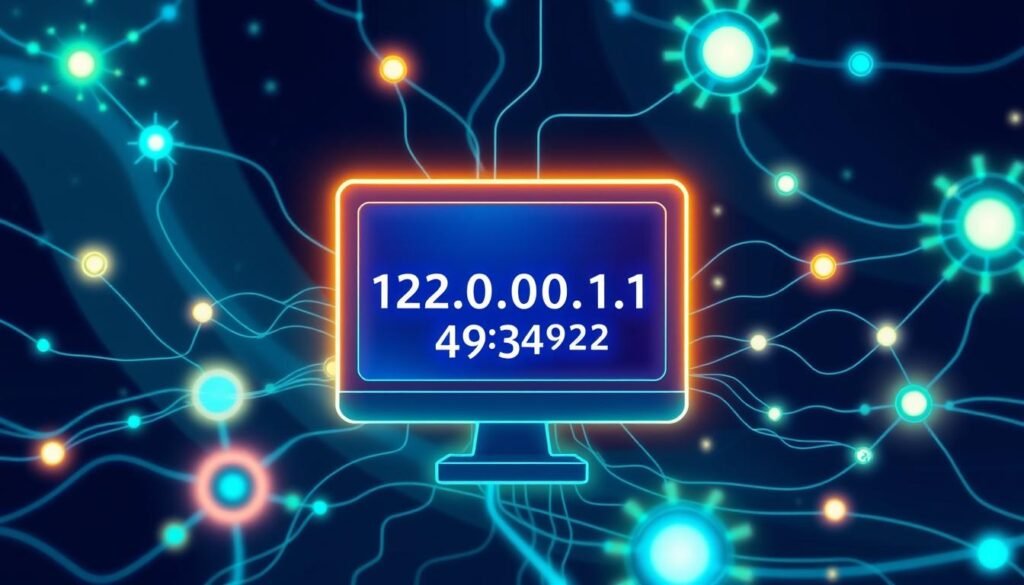
Did you know that about 60% of computer network problems can be fixed with localhost? This fact shows how important 127.0.0.1 is in network communication. It acts as a key entry point for troubleshooting, letting users test apps on their local network without outside help.
In this article, we’ll look into the role of 127.0.0.1:49342 in local network insights. We’ll help you understand how localhost works in computer networks. By the end, you’ll know why the localhost IP address is crucial for developers and network admins.
Understanding the Basics of Localhost
The term localhost refers to the local computer we use every day. It is linked to the localhost ip address, which is usually 127.0.0.1 on most systems. This address is key for testing apps and services on our computers without needing the internet.
Knowing about networking basics is crucial for working with networked devices. The localhost ip address helps apps talk to their host system. This makes data transfer smooth during development and when fixing issues.
To understand how devices talk to each other in a local network, we need to know about protocols. These rules help devices send and get information. Using localhost makes this easier, as it avoids the need for complex setups found in bigger networks.

What is the Role of 127.0.0.1 in Networking?
The IP address 127.0.0.1 is key in networking. It’s called localhost and helps devices talk to each other. It’s vital for developers and network experts to know how it works.
This address lets users test apps safely. It helps check network protocols and fix code issues. Many networking roles use 127.0.0.1 for its benefits:
- Running web servers for local development.
- Testing and debugging applications before deployment.
- Creating virtual environments for software testing.
Using localhost makes network management easier. Courses teach its importance for local work and learning networking basics.

Exploring 127.0.0.1:49342
The address 127.0.0.1:49342 is key in local network talks. Knowing its role helps improve network apps. It’s vital for developers and IT folks.
The port 49342, linked to 127.0.0.1, supports local testing and development. It lets users test web apps and databases on their computers.
Definition and Significance
The local server port 49342 is for services on a local network. It’s great for hosting web apps and databases on your machine. Using 127.0.0.1:49342 lets developers test apps locally, like they’re in production.
This setup is safe for testing. It makes sure network apps work right before they go live.
Common Use Cases
There are many times when 127.0.0.1:49342 is needed:
- Testing web apps in development to fix bugs without messing with a live server.
- Running API services locally for easy testing and checking responses.
- Creating database management systems that need internal access before they’re public.

The Importance of IP Addresses
IP addresses are key in networking, serving as unique IDs for devices on a network. Each device needs its own IP address for good computer connectivity. This ensures proper communication across different platforms.
There are two main types of IP addresses: dynamic and static. Dynamic IP addresses are given out temporarily while a device is online. This helps use IP address space well in big networks. Static IP addresses stay the same, which is crucial for devices needing constant access, like servers or printers.
The link between IP addresses and routing is crucial in local networks. Each data packet sent over the network has the sender’s and receiver’s IP addresses. This makes sure the data gets to where it’s meant to go. It boosts communication and makes device connections stronger.

Knowing how important IP addresses are helps people understand networking basics. It shows how these identifiers work. This knowledge can make computer connectivity better, leading to smoother interactions and data sharing.
How to Configure IP Settings on Your Computer
Setting up your IP settings is key for a stable connection to local and internet networks. The steps differ for Windows and Mac. Here’s a detailed guide to help with your ip configuration needs and common issues.
Step-by-Step Guide to Configuring IP Settings
Follow these steps based on your operating system:
- For Windows:
- Open the Control Panel and select Network and Sharing Center.
- Click on Change adapter settings.
- Right-click your active network connection, and select Properties.
- Highlight Internet Protocol Version 4 (TCP/IPv4) and click Properties.
- To set a static IP address, select Use the following IP address and enter your desired IP settings.
- For Mac:
- Navigate to System Preferences and select Network.
- Choose your network connection from the list on the left.
- Click on Advanced, and go to the TCP/IP tab.
- Change the Configure IPv4 to Manually and enter your IP configuration details.
Common Challenges and Solutions
While setting up your ip settings, you might run into some issues:
- IP Conflicts: If two devices have the same IP address, you won’t connect. Make sure each device has a unique address.
- No Internet Access: If your settings are wrong, you won’t get online. Check your settings again.
- Network Troubleshooting: Use the built-in network troubleshooter for problems. It can find and fix issues quickly.
Network Communication Explained
Understanding network communication is key for those setting up local networks. It’s about how data moves between devices. Devices can talk, share, and work together thanks to these processes.
Local networks use two main ways to communicate: client-server and peer-to-peer. The client-server model has servers that offer services to many clients. Peer-to-peer connections let devices share directly, making networks more flexible and collaborative.
Protocols are vital for good network communication. TCP/IP helps data packets move in an orderly way. UDP is faster but less reliable. Both are needed for better network performance.
For data to move well, networks need to be efficient and secure. This means finding the best paths and keeping data safe from hackers. Good encryption and authentication keep data secure in local networks.
Common Internet Protocols in Local Networks
Knowing about internet protocols is key for smooth communication in local networks. These protocols set the rules for data exchange, making sure devices can talk to each other easily. TCP/IP and UDP are two main protocols used in local networks.
Overview of TCP/IP Protocol Suite
The TCP/IP protocol suite is the base for internet and local network communication. It has a layered structure:
- Application Layer: This layer helps software applications talk to lower layers.
- Transport Layer: Here, TCP and UDP manage data sending. TCP ensures data is sent reliably, while UDP is faster and doesn’t need a connection.
- Internet Layer: This layer sends data packets across networks using Internet Protocol (IP).
- Link Layer: It deals with physical network connections, handling local network interfaces.
TCP/IP’s design helps different devices work together, making it a common choice for local networks.
Role of UDP in Networking
User Datagram Protocol (UDP) is important in networking, especially for fast services. Unlike TCP, UDP sends packets without a connection, which is quicker. This makes UDP great for:
- Streaming media.
- Online gaming.
- Voice communications.
UDP doesn’t have error-checking, but its speed is perfect for real-time apps where quick data is crucial.
Network Troubleshooting Techniques
Effective network troubleshooting is key for a smooth user experience. When you face connectivity problems, start by using tools like ping, traceroute, and ipconfig. These tools help find and fix issues that block service.
Understanding your network’s physical setup is also important. Make sure cables are plugged in right and not damaged. Tools like Wireshark can help spot problems in network traffic.
Keeping records of your network settings is helpful too. This way, you can easily go back to a working setup if something new goes wrong. Using these methods helps fix problems now and keeps your network running well. Read more articles…







